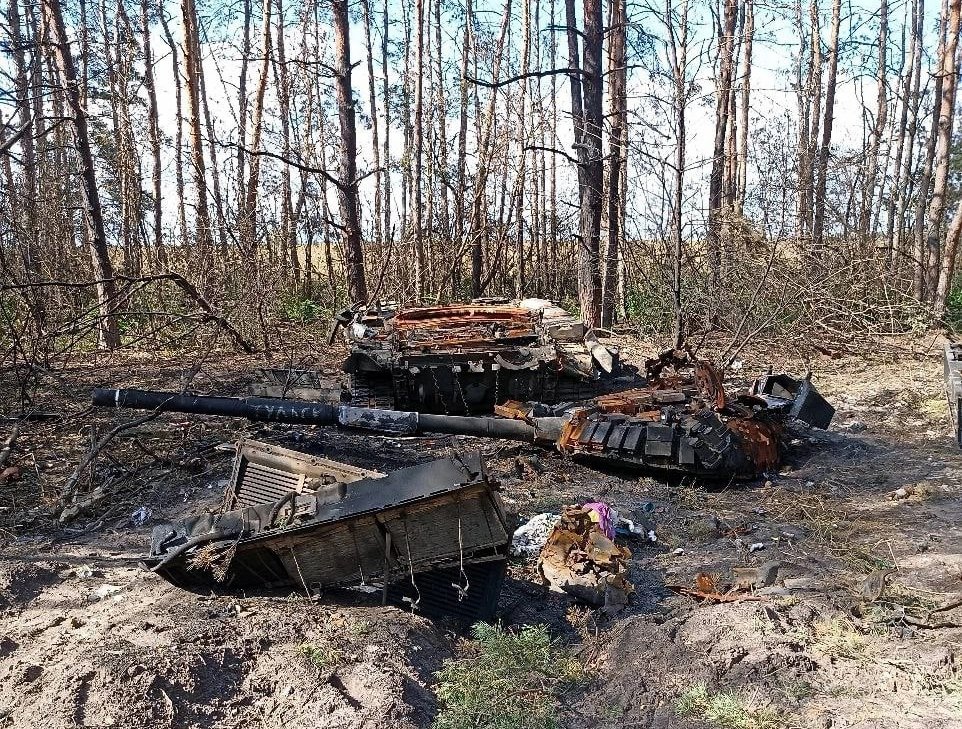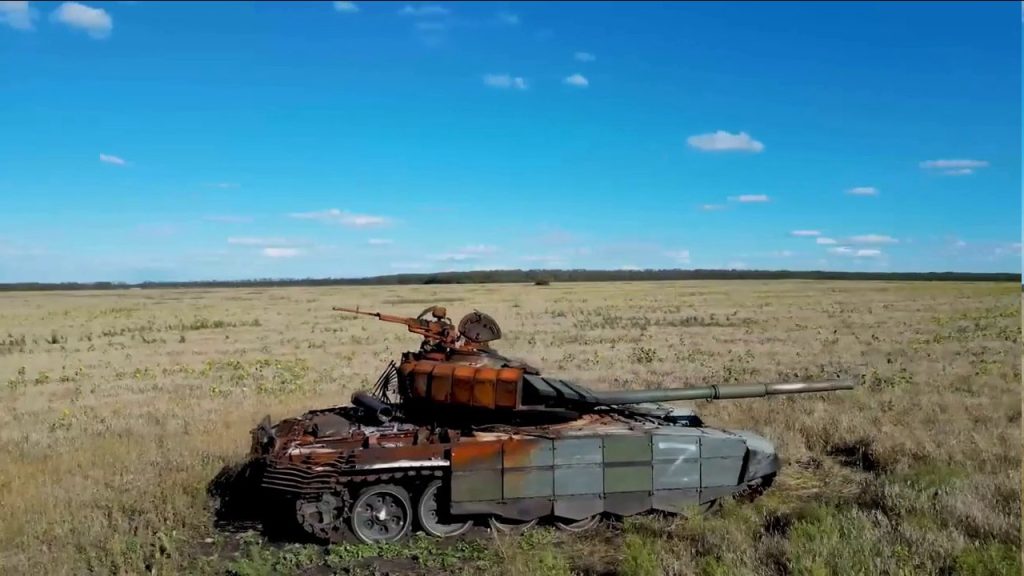
Verzija teksta na srpskom jeziku autora Aleksandra Bogićevića dostupna je na sledećem linku: Tekst na srpskom jeziku
On September 21, virtually all global media reported that Russian authorities declared a partial mobilization within the Federation. The Russian president’s speech and the new measures seem to have shed new light on everything that happened in Ukraine in late August and early September. Namely, the previous period was marked by two great counteroffensives by the Ukrainian forces, the first large-scale operations since the beginning of the Russian aggression against this country. One counteroffensive commenced in the south in the tactical direction of Kherson, while the other was carried out in the east in the tactical direction of Kupyansk and Izium.
Although the goals and results of the operations in the Kherson area are still not crystal clear, the fighting outcome in the Kharkiv region is concrete – the Ukrainian army has secured a significant victory. While it had taken the Russian armed forces months to gradually occupy and seize this area, the Ukrainian forces liberated it in just a few days. The liberation of the territories in the north-east, particularly of the city of Izium, has also signalled two crucial things: first, that the Ukrainian forces are capable of carrying out large-scale, well-coordinated and well-planned offensive operations, confirming previous suppositions and assumptions; and second, that the Russian Federation, with all the resources it is currently investing, is further and further away from achieving its goals in Ukraine.
In the Kherson conflict zone, the front line has practically not moved since March, despite the efforts of both sides to force the other to retreat. For months, Russian troops fighting in this area have been active in the most vulnerable part of the front, seeing that they are stationed farthest from Russian territory. Above all, this poses logistical challenges and notably hinders the equipping of troops, whilst the supply lines for the Ukrainian units are significantly shorter, especially when it comes to weapons imported from the West. To make matters worse for the Kremlin’s strategists, the two bridges connecting the banks of the Dnieper have become constant targets of precise artillery fire from the Ukrainian side, which severely complicates the logistical support to the units on the battlefield. The defeat and loss of this bridgehead would represent a crucial strategic defeat for the Russian army, as Kherson is the only territory it holds on the left bank of the Dnieper and its loss would obstruct possible attacks towards Mykolaiv and Odesa in the west and Kryvyi Rih in the north. All these factors made this sector an obvious target and the starting point for the Ukrainian counteroffensive.

The battlefield around the city of Izium has, however, lately become more static. After the retreat of Russian troops from the vicinity of Kyiv in April, Izium became one of the focal points for Russian forces, from which they threatened to penetrate the defence in the Donbas region and occupy several strategically vital hubs, such as the cities of Sloviansk, Kramatorsk and Barvinkove. What made this city particularly important was its direct and close connection to Russia via the railroad that went through Kupyansk to Belgorod, from which came supplies and reinforcements. Although Russian units carried out constant attacks on Ukrainian positions south and west of Izium for months, the front line did not move significantly, especially not in the west, where units from the Kharkiv and Husarivka conflict zones prevented the enemy's advance. Due to the importance Izium carries in light of the future operations in Donbas, the main battlefield, it was assumed to feature numerous well-fortified Russian positions, supported by a significant amount of military equipment. If the complexity of the terrain, stemming from dense forests and rivers, through which the Ukrainian forces would have to advance is considered, a counterattack was somewhat unexpected to occur in this area. Nonetheless, taking into account that the Russian troops would be at risk of being cut off if the Ukrainian forces gained control of Izium or any section of the abovementioned railway, it is obvious why the Ukrainian Army General Staff was willing to risk an operation that could go awry in so many ways.
On August 29, Ukrainian units launched an offensive in the south of the country by attacking from several directions to cut off and capture Russian troops on the right bank of the Dnieper River, where they could be defeated very quickly due to interrupted supply and support chains. The offensive entailed the execution of various tasks in several directions of advance - the units deployed along the Mykolaiv-Kherson highway and the area of the town of Vysokopillya were tasked with flanking Russian units, while the penetration across the Inhulets River near the town of Davydiv Brid was supposed to break the Russian defense line in half and secure the capture of the city of Nova Kakhovka and the critical bridge that served as one of the main communication links of the Russian troops with its rear. The isolation of the Russian forces on the right bank of the Dnieper should have been facilitated by the Ukrainian side’s precise artillery fire, which succeeded in damaging the bridges but failed to completely cut off the Russian forces. In addition to the abovementioned means of supply, the Russians also received reinforcements and war materials over the installed pontoon bridges.

As predicted by the plan, the biggest advance was achieved by crossing the Inhulets River, where the Ukrainian forces quickly transferred their equipment to the other bank, began to advance deep into the territory and created a wedge in the opponent's defence. A few days later, the Russian forces managed to consolidate after the initial shock and caused significant damage to the most advanced units. This offensive swiftly turned from a maneuver into a positional war, in which the Russian artillery and aviation supremacy prevailed, which made further advances impossible without a more extensive engagement of Ukrainian reservists. The main contributor to the poor results of the operation can be attributed to the terrain on which the offensive was carried out. Namely, the terrain over which Ukrainian forces were supposed to advance offered little cover from reconnaissance and artillery fire, thus impeding the assembly and advance of the troops. Maintaining logistical support over the Inhulets River also proved to be a daunting task due to the constant attacks by Russian artillery and aviation, which additionally affected the further military advance.
However, taking a comprehensive look at the overall war context and the subsequent offensive of the Ukrainian forces in the northeast, the question arises as to what the goal of the operation in the south was - was it to capture Kherson and Nova Kakhovka and defeat Russian forces, or to distract the enemy command and engage the reservists in an active conflict zone to create an opportunity to attack a sector where an attack would not be expected, that is, in the vicinity of Izium. If the aim was to capture Russian positions on the right bank of the Dnieper, then the Ukrainian offensive failed dismally. Numerous well-trained units, especially infantry and their Western-weapon armed vehicles, have suffered dire losses that Kyiv will struggle to rapidly recuperate. Additionally, the lack of substantive reservists that would provide military support and the misselection of the operation’s target – bridges of the Inhulets River – point towards tactical errors at the Ukrainian army headquarters.

If the battle's aim, however, was to distract the Russian military command from the real offensive, as Ukrainian officials claim, the operation could be considered a great success. Due to the participation of highly-trained Ukrainian troops in this conflict zone, the great presence of Western-produced equipment and the obvious vulnerability of Russian positions in this area, Moscow headquarters had every reason to believe that this was a large-scale counteroffensive with the aim of banishing Russians from Kherson, not a mere distraction. The fear that the Ukrainian forces could extinguish all their hopes of occupying the entire Black Sea coast forced the Kremlin to send a large section of its reservists to this zone, which, according to Kyiv's interpretations, made the Russians fall into a trap. However, considering the resources Ukraine has invested as well as battle tenacity (fierce combat in this conflict zone is still ongoing at the time of writing this analysis), one can say that this was an offensive of the highest importance for Kyiv, with a goal that was not just a pure distraction.
A few days later, on September 6, Ukrainian forces launched an offensive in the direction of the Oskil River intending to capture Kupyansk and Izium, which would further protect Kramatorsk and Sloviansk, the most important Ukrainian cities in the Donbas area. Even though analysts have suggested for weeks that Ukrainian forces have been congregating in the Kharkiv region and that they could attack from several directions, one of which is Izium, it is clear that the Russian headquarters did not attribute much to that data. The relief and lush vegetation, which made concealing military activities possible, prevented Russians from detecting Ukrainian troops before the attack, so their first strike was met with surprise, not the fierce use of Russian artillery as was the case in Kherson. With rapid assaults, Ukrainian units managed to pierce the Russian Army front lines north of the town of Balakliya and, instead of stalling and consolidating their gains (as had been done in this conflict up to that moment), the Ukrainians decided to continue their invasion further towards Kupyansk, thus keeping the maneuvering character of the operation.
The Russian authorities’ first response was to focus on Balakliya and attack the Ukrainian rear, as seen by fierce air strikes on the city of Chuhuiv, the assumed command and logistics centre of the Ukrainian forces in this area. The assumption was that the scenario seen in Kherson a few days before would be repeated – and that the Ukrainian advance would be taking place along a narrow corridor susceptible to attacks from the flanks, artillery and aviation strikes. It would only be a matter of time before Kyiv realised that further losses did not justify gains. Nevertheless, a large number of reservists gathered near Husarivka to replace the units from the first wave of attacks, maintained the initial momentum and pushed towards Kupyansk, an indispensable railway hub in the region.
A few days after the onset of the offensive, when Russian authorities understood the gravity of the situation, all available forces were dispatched to the region to prevent further advances of Ukrainian troops towards Kupyansk and the Oskil River. Although it seemed that Russian forces would manage to halt the entire offensive to the south of Kupyansk, the destruction of the bridge connecting the two parts of the city (it is still unclear which side is to blame) has signalled Moscow's admission of defeat. A day later, a decision was made to retreat Russian units from both the city of Izium and the Kharkiv area, which completed Kyiv’s victory.
The Izium offensive thus had consequences that go way beyond the situation in the Kharkiv region. First of all, the victory has provided the Ukrainian population with a huge moral boost and served as proof to the Western partners that their efforts in arming, financing, informing, and training have not been in vain but, in turn, brought noticeable results. The victory should also reduce the pressure the Western partners have exerted on President Zelenskyy and, consequently, on Chief of General Staff Zaluzhnyi to organize a counterattack in order to justify the previous and future investments in the Ukrainian army. Furthermore, a great victory could inspire the continuation and expansion of the war material supply from the West, particularly when it comes to systems and weapons that are yet to be used or have been used to a lesser extent, such as the US-made AGM-88 anti-radar missile integrated on Ukrainian MiG-29 aircraft.

These operations have also shown the world that the Armed Forces of Ukraine are capable of offensive operations, not just of entrenchment, defence, and limited-capacity local counterattacks. It should not be forgotten that Ukrainians have managed to integrate and use in combat a large quantity of various Western-made weapons, which suggests that the Ukrainian forces or at least some of their brigades, have succeeded in mastering these systems. This could, in turn, facilitate the further supply and inclusion of new weapons in the composition of its armed forces. Finally, it should be kept in mind that units in Izium and Kherson have suffered dire losses in personnel and equipment, especially during operations in the Kherson area. Considering that the best-trained and equipped units were simultaneously the most exposed ones, these losses are disproportionate and could pose a severe threat to Kyiv in the long run.
The Kremlin, however, does not have much to boast about. After the capture of Severodonetsk and Lysychansk in late June and early July and villages near Avdiivka and Bakhmut during the summer, the front line has practically stalled. Since the beginning of September, Russia has paid a high price for its confidence in its superiority and the assumption that the other side will be passive. Particularly gripping is the fact that the Ukrainian forces succeeded in catching the Russians completely off-guard near Balakliya despite numerous pieces of evidence suggesting that they were gathering in a tiny area, which only demonstrates how lax the Russian troops were. Another humiliating fact for the Russian side is that, except for the smaller special units engaged in Balakliya, the troops in this conflict zone provided little resistance and retreated rapidly. Of course, a fast retreat also meant leaving behind a great deal of military equipment, a large portion of which was still operational, which only points towards the speed and disorganisation of the Russian retreat from the Izium and Kupyansk areas. The extent of the damage suffered by the Russian units is best described by the Oryx site researchers, who keep records of destroyed, damaged, and captured military equipment during the conflict through images and videos. In just two weeks of the Ukrainian offensive, they identified 151 infantry fighting vehicles and 104 tanks destroyed or captured by the Ukrainians.
Encouraged by the victories in the east, Kyiv is now suggesting new offensives intending to banish Russians from other regions as well. Kherson, Lysychansk and Severodonetsk are still potential targets, and so is Mariupol, a port on the Sea of Azov 75 km from the front line (for example, the distance between Balakliya and Kupyansk is 60 km, and Ukrainian forces covered it in 3 days). Reports registering the transfer of mechanised units from the Kharkiv front to the vicinity of Mariupol and Vuhledar, a town located north of Volnovakha, an important railway hub, indicate that a future offensive could be directed toward the coasts of the Black Sea and the Sea of Azov.
For Moscow and the highest political and military decision-makers, this defeat represents an alarm because the army has, from the very beginning of the war in February, obviously been facing huge problems impeding it at every step. These issues have begun to cause defeats that can no longer be masked as strategic retreats, coincidences, accidents (as was the case with the "Moscow" cruiser), and concessions for humanitarian reasons, as was said in the case of the Zmiinyi (Snake) Island. There is an obvious discrepancy between Moscow’s goals and resources, primarily in manpower, that it is ready to invest in the fulfilment of those goals, which leads to the waste of resources and defeats, such as the retreat from the vicinity of Kyiv and the loss of the city of Izium.
Despite the superiority in the quantity of military equipment that exists both on paper and on the battlefield, its inadequate use, poor leadership, lack of infantry support and will to fight compared to its opponent are hindering all Russian efforts to topple the progressively emboldened regime in Kyiv, which can now expect even greater support from the West, mostly in modern weapons systems. The increasingly better-armed and courageous Ukrainian army has shown Russia that it has evolved during the previous 200 days of warfare and that Russian forces will need a vital change in their approach to war to break the Ukrainian resistance, primarily in terms of mobilising industry and manpower. The initial step in that direction was made by Vladimir Putin by announcing in his speech the partial mobilisation of about 300,000 reservists. In addition to this mobilisation, the announcement of the referendum acceleration in Kherson, Luhansk, Donetsk and Zaporizhzhia could instigate the annexation of these areas to the Russian Federation, which would make further Ukrainian efforts to regain these territories difficult. Attacking territories that Russia has legally annexed would provide Moscow with a casus belli for complete mobilisation as well, which would make an already destructive war even more devastating and lethal.
Translated and proofread by: Milica Milosavljevic
Author: Aleksandar Bogicevic

